The Television Legacy of Irwin Allen – Part II: Voyage to the Bottom of the Sea
 Irwin Allen had his sights set on his first science fiction television series before its 1961 feature film counterpart was even completed. Wisely realizing that the cost of special effects would be the biggest hurdle in selling a series of this type, Allen filmed the big screen version of Voyage to the
Irwin Allen had his sights set on his first science fiction television series before its 1961 feature film counterpart was even completed. Wisely realizing that the cost of special effects would be the biggest hurdle in selling a series of this type, Allen filmed the big screen version of Voyage to the 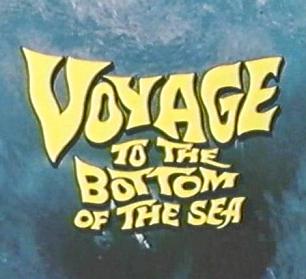 Bottom of the Sea with a keen eye towards stock footage. The more footage he could recycle from the feature, the lower the overall budget of the television series would be and the more money there would be available to spend in other areas. His vision paid off and he was able to sell the series to the ABC Television Network based on a color pilot that introduced the modified storyline while making the most of the available sets, costumes, and effects footage.
Bottom of the Sea with a keen eye towards stock footage. The more footage he could recycle from the feature, the lower the overall budget of the television series would be and the more money there would be available to spend in other areas. His vision paid off and he was able to sell the series to the ABC Television Network based on a color pilot that introduced the modified storyline while making the most of the available sets, costumes, and effects footage.
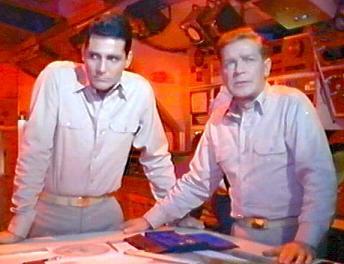
David Hedison and Richard Basehart on the set of Voyage to the Botom of the Sea.
Replacing lead actors Walter Pidgeon and Robert Sterling from the feature were hard working actor Richard Basehart as Admiral Harriman Nelson and David Hedison, who had previously worked for Irwin Allen in the 1960 film The Lost World, as Captain Lee Crane. The duo worked well together whether the material was deadly serious or more light hearted in tone with Crane often the voice of reason clashing against Nelson’s scientific curiosity. Rounding out the submarine’s crew were Robert Dowdell as the often perplexed Lt. Commander Chip Morton, Henry Kulky as the salty Chief Curly Jones (first season only), and the sole carry-over actor from the feature, Del Monroe, as Crewman Kowalski. There would be other recurring characters throughout the series four seasons and countless guest stars but this quartet of characters made up the core dynamic.
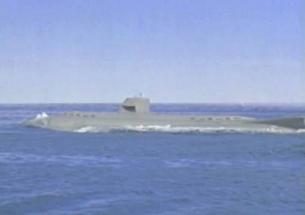
The fantastic submarine Seaview.
Premiering in the fall of 1964, the first season of Voyage to the Bottom of the Sea was filmed in black and white and the stories reflected the more somber atmosphere. While there was the occasional visitor from space, giant beastie, robot, or genetically engineered amphibian creature, most of season one’s stories dealt with political intrigue like assassination attempts, sabotage, and cold war spies. One stand out episode from this time, Submarine Sunk Here, finds the Seaview trapped in a derelict mine field (stock footage from the feature) and coming perilously close to destruction. On the flip side, Turn Back the Clock put the submarine’s crew on a tropical oasis in the middle of Antarctica battling dinosaurs! If you guessed that stock footage for this episode was recycled from The Lost World then you are starting to understand the Irwin Allen cost cutting strategy!
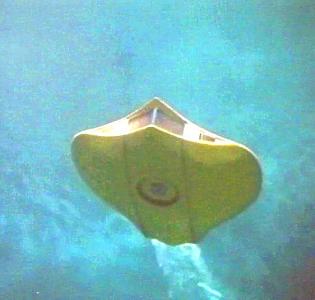
The Flying Sub introduced in season two.
After a successful inaugural run, Voyage returned for a second season and this time the show was in beautiful color. While by no means abandoning stock footage, Allen was able to beef up the special effects in season two and added one of the show’s most memorable elements, the bright yellow manta shaped Flying Sub. This clever little craft made it much easier for members of the crew to travel between the submarine and land without having to dock so it improved the pace and variety of the stories. The Seaview herself received a make-over and slight technological upgrade with the eight section window on the front reduced to four and the streamlining of the observation room and nose. Also added this season was actor Terry Becker as Chief Francis Sharkey, a slightly less crusty and more mobile version of Curly Jones.
Reflecting the more colorful look of season two, the stories began to drift toward fantasy elements. The ABC network, perhaps in response to the looming Vietnam War, had asked Allen to down play the military themed stories in favor of more science fiction and fantasy and he was happy to comply. Some of these episodes like The Phantom Strikes, dealing with a ghost from World War I, and The Shape of Doom, where a genetically enhanced whale swallows a nuclear warhead, actually work fairly well. Others, like The Creature’s Web, which features a laughably designed giant spider that found its way into many other productions, just don’t cut it. Thankfully, there was still some tight dramas to be found this season with standout episodes like The Graveyard of Fear, Time Bomb, and The Silent Saboteurs. For those fans of stock footage, Fire in the Sky recycled much of the plot and effects from the feature film and the creatures of The Lost World were back in Terror on Dinosaur Island!
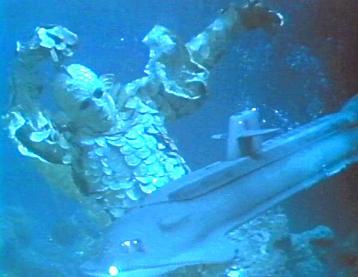
One of the sillier monsters from the later episodes menaces the Seaview.
The first episode from the third season, Monster from the Inferno, where an evil alien brain, voiced by Dick Tufeld who also provided the vocals for the robot on Allen’s Lost in Space, tries to take over of the Seaview by controlling the crew, sums up the direction the series had taken by this point. Where season two had wavered between the serious and the fantastic, season three firmly embraced the outlandish. This season the submarine’s crew would battle werewolves, mummies, killer toys, plant monsters, and even wax effigies of themselves! There were still a few good episodes like Death from the Past with its revived Nazis or the genuinely creepy Shadowman but it was obvious from the start that a show that had once prided itself on strong dramatic stories had now set its sights much lower.
The fourth season of Voyage to the Bottom of the Sea would also be its last. The ratings had begun to slip with the third season and Irwin Allen continued to produce stories that favored creatures over creativity. This year the Seaview would be visited by the abominable snowman, leprechauns, lobstermen, and Blackbeard’s ghost but not by an increased number of viewers. Ironically, the final episode of the series, No Way Back, begins with the destruction of the Seaview and Admiral Nelson spends the remainder of the story going back in time to try and save it. Unfortunately, Richard Basehart couldn’t really go back in time and tell Irwin Allen to lay off the way out scripts or he might have been able to save the series along with the sub!
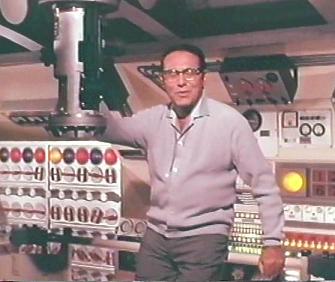
Irwin Allen on the set of Voyage introducing the show to potential sponsors.
The demise of Voyage was due as much to the slipping ratings and declining story quality as it was to Irwin Allen feeling the material had grown stale. In 1968, ABC had shown interest in renewing the show for a fifth season but Allen had a counterproposal. He created a short film comprised of production sketches and stock footage, mainly from Lost in Space, and sold the network on producing a new series, Land of the Giants, instead.
After four seasons and 110 episodes, the Seaview sailed off into the sunset for the final time. Voyage to the Bottom of the Sea was Irwin Allen’s longest running television series and its central theme of underwater adventure was not one he would quickly abandon. In 1969 he would film a pilot for another series titled City Beneath the Sea that relied heavily on recycled props, including the Flying Sub, from Voyage. When the pilot was not picked for as a series, Allen expanded the plot and released it two years later as a made for television movie.
